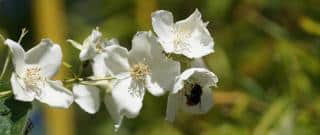

Mock-orange is a very beautiful shrub that blooms abundantly in spring and at the beginning of summer.
Main Mock-orange facts
Name – Philadelphus
Family – Hydrangeaceae
Type – shrub
Height – 3 to 10 feet (1 to 3 m)
Exposure – full sun, part sun
Soil – ordinary
Foliage – deciduous
Flowering – May and June
Planting, pruning and caring for mock-orange support its development and help avoid diseases.
It is a good idea to plant your mock-orange in fall but you can also plant in spring if you’re able to water regularly the first year after planting.
Mock-orange is easy to propagate through cuttings, it is even the easiest way overall to produce new mock-orange trees.
Mock-orange, if properly settled in, only requires quite little care and attention.
Mock-orange best copes with being pruned every year, so that young branches have a chance of growing and old wood is eliminated.
As for watering, mock-orange must be watered in case of high temperatures and/or of extended dry spell.
Potted mock-orange must normally be watered much more often than that planted in the ground.
All year long, it is important to clear around the foot of the mock-orange to remove weeds and ensure the water drains well around the roots.
Adding all-purpose fertilizer in spring will boost growth, blooming and make the leafage magnificent.
This very beautiful shrub blooms in June, but often even starts in May.
It then emits a persistent and appealing fragrance in the entire garden, and also has the advantage of being quite hardy.
It only requires very little care, and can make do in any spot of your garden.
Mock-orange gave rise to many different hybrids, either with simple or double flowers, for the greatest pleasure of the eyes and the nose!
Expect your mock-orange, whatever the species, to grow more and more sparse as years go by.
 Mock-orange isn’t often sick, and resists particularly well to most fungus and diseases.
Mock-orange isn’t often sick, and resists particularly well to most fungus and diseases.
However, it can happen that parasites will attack it, like aphids and mealybugs or scale insects.
Mock-orange will love it if you give it fertilizer in spring, especially when you feel it weakening.
See also:
My sweet mock orange bush does not smell at all. I’d love to have a sweet orangy fragrance. How can I get this from this mature shrub? It is probably 10 yrs old or maybe more. I’ve had it so long I can’t remember when I got it. Thanks.
Hello Julia, that might be difficult to get: it depends a lot on the variety. There are a few things to try out, though. It might be that a few key nutrients are missing from that particular patch of soil, so the scent doesn’t form well. The best way to counter this is to bring in plant materials from other parts of the garden, or, even better, from a garden with a very different type of vegetation. Maybe you can strike a deal with a friend to bring over their garden trimmings instead of dropping it off at the landfill or recycling center?
To use them, it’s best to make fermented weed tea out of it. Second best is to spread it under the mock-orange for mulch, where it’ll slowly break down.
As an afterthought, it might also be that the plant isn’t mock-orange at all – I’ve often made mistakes in identifying plants. For that, post a few pictures on the Plant Identification forum, and you’ll quickly get an answer.
What type fertilizer should I use for a mature mock orange?
Hello Debbie, mock orange will be perfectly happy with all-purpose fertilizer, but what will really do it good is any type of home-made fertilizer.
The ultimate fertilizer is when you can recycle trimmings from the mock-orange itself into fertilizer: you’re giving it back exactly what it needs. Using plants from the same family helps, too: any of the Hydrangeaceae plants will do great. If not easy to find, just go for any plant in the garden, weeds especially (they have a knack for finding nutrients everywhere).
To make the fertilizer, two courses of action:
• Solution 1: chop the plant material up and set it out to dry (or dry it first and crush it later, whichever suits you). Then, spread it as a layer of plant-based mulch around the mock-orange.
• Solution 2: prepare fermented tea with the material, and add it during watering sessions.